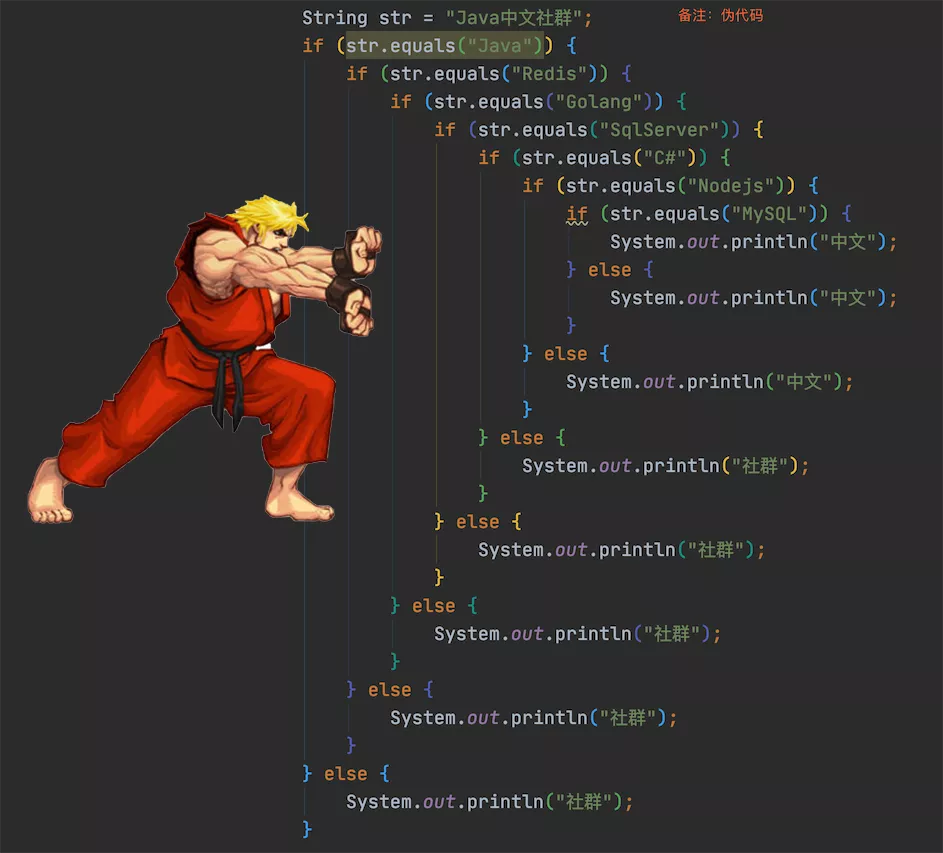if else 是我们写代码时,使用频率最高的关键词之一,然而有时过多的 if else 会让我们感到脑壳疼,例如下面这个伪代码:
是不是很奔溃?虽然他是伪代码,并且看起来也很夸张,但在现实中,当我们无数次 review 别人代码时,都会发现类似的场景,那么我们本文就来详细聊聊,有没有什么方法可以让我们避免来写这么多的 if else 呢?
1.使用 return
我们使用 return 去掉多余的 else,实现代码如下。
优化前代码:
if (str.equals("java")) {// 业务代码 ! true;} else {return ;}
优化后代码:
if (str.equals("java")) {return ;}return false;
2.使用 Map
使用 Map 数组,把相关的判断信息,定义为元素信息可以直接避免 if else 判断,实现代码如下。
优化前代码:
if (t == 1) {type = "name";} else if (t == 2) {type = "id";} else if (t == 3) {type = "mobile";}
我们先定义一个 Map 数组,把相关判断信息存储起来:
Map<Integer, String> typeMap = new HashMap<>();typeMap.put(1, "name");typeMap.put(2, "id");typeMap.put(3, "mobile");
之前的判断语句可以使用以下一行代码代替了:
type = typeMap.get(ty);
3.使用三元运算符
三元运算符也叫三元表达式或者三目运算符/表达式,不过代表的都是一个意思,优化代码如下。
优化前代码:
Integer score = 81;if (score > 80) {score = 100;} else {score = 60;}
优化后代码:
score = score > 80 ? 100 : 60;
4.合并条件表达式
在项目中有些逻辑判断是可以通过梳理和归纳,变更为更简单易懂的逻辑判断代码,如下所示。
优化前代码:
String city = "西安";String area = "029";String province = "陕西";if ("西安".equals(city)) {return "xi'an";}if ("029".equals(area)) {return "xi'an";}if ("陕西".equals(province)){return "xi'an";}
优化后代码:
if ("西安".equals(city) || "029".equals(area) || "陕西".equals(province)){return "xi'an";}
5.使用枚举
JDK 1.5 中引入了新的类型——枚举(enum),我们使用它可以完成很多功能,例如下面这个。
优化前代码:
Integer typeId = 0;String type = "Name";if ("Name".equals(type)) {typeId = 1;} else if ("Age".equals(type)) {typeId = 2;} else if ("Address".equals(type)) {typeId = 3;}
优化时,我们先来定义一个枚举:
public enum TypeEnum {Name(1), Age(2), Address(3);public Integer typeId;TypeEnum(Integer typeId) {this.typeId = typeId;}}
之前的 if else 判断就可以被如下一行代码所替代了:
typeId = TypeEnum.valueOf("Name").typeId;
6.使用 Optional
从 JDK 1.8 开始引入 Optional 类,在 JDK 9 时对 Optional 类进行了改进,增加了 ifPresentOrElse() 方法,我们可以借助它,来消除 if else 的判断,使用如下。
优化前代码:
String str = "java";if (str == null) {System.out.println("Null");} else {System.out.println(str);}
优化后代码:
Optional<String> opt = Optional.of("java");opt.ifPresentOrElse(v ->System.out.println(v), () -> System.out.println("Null"));
7.梳理优化判断逻辑
和第 4 点比较类似,我们可以通过分析 if else 的逻辑判断语义,写出更加易懂的代码,例如以下这个嵌套判断的优化。
优化前代码:
// 年龄大于 18if (age > 18) {// 工资大于 5000if (salary > 5000) {// 是否漂亮if (pretty == true) {return true;}}}return false;
优化后代码:
if (age < 18) {return false;}if (salary < 5000) {return false;}return pretty == true;
8.使用多态
继承、封装和多态是 OOP(面向对象编程)的重要思想,本文我们使用多态的思想,提供一种去除 if else 方法。
优化前代码:
Integer typeId = 0;String type = "Name";if ("Name".equals(type)) {typeId = 1;} else if ("Age".equals(type)) {typeId = 2;} else if ("Address".equals(type)) {typeId = 3;}
使用多态,我们先定义一个接口,在接口中声明一个公共返回 typeId 的方法,在添加三个子类分别实现这三个子类,实现代码如下:
public interface IType {public Integer getType();}public class Name implements IType {@Overridepublic Integer getType() {return 1;}}public class Age implements IType {@Overridepublic Integer getType() {return 2;}}public class Address implements IType {@Overridepublic Integer getType() {return 3;}}
注意:为了简便我们这里把类和接口放到了一个代码块中,在实际开发中应该分别创建一个接口和三个类分别存储。
此时,我们之前的 if else 判断就可以改为如下代码:
IType itype = (IType) Class.forName("com.example." + type).newInstance();Integer typeId = itype.getType();
9.选择性的使用 switch
很多人都搞不懂 switch 和 if else 的使用场景,但在两者都能使用的情况下,可以尽量使用 switch,因为 switch 在常量分支选择时,switch 性能会比 if else 高。
if else 判断代码:
if (cmd.equals("add")) {result = n1 + n2;} else if (cmd.equals("subtract")) {result = n1 - n2;} else if (cmd.equals("multiply")) {result = n1 * n2;} else if (cmd.equals("divide")) {result = n1 / n2;} else if (cmd.equals("modulo")) {result = n1 % n2;}
switch 代码:
switch (cmd) {case "add":result = n1 + n2;break;case "subtract":result = n1 - n2;break;case "multiply":result = n1 * n2;break;case "divide":result = n1 / n2;break;case "modulo":result = n1 % n2;break;}

